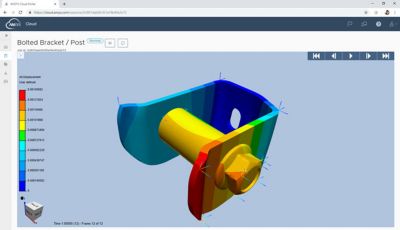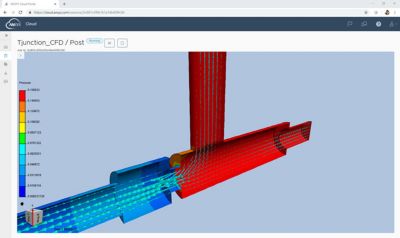-
United States -
United Kingdom -
India -
France -
Deutschland -
Italia -
日本 -
대한민국 -
中国 -
台灣
-
Ansys s'engage à préparer les étudiants d'aujourd'hui à la réussite, en leur fournissant gratuitement un logiciel de simulation.
-
Ansys s'engage à préparer les étudiants d'aujourd'hui à la réussite, en leur fournissant gratuitement un logiciel de simulation.
-
Ansys s'engage à préparer les étudiants d'aujourd'hui à la réussite, en leur fournissant gratuitement un logiciel de simulation.
-
Contactez-nous -
Carrières -
Étudiants et universitaires -
-
S'inscrire -
Déconnexion -
Espace client -
Support -
Communautés partenaires -
Contacter le service commercial
Pour les États-Unis et le Canada
+1 844.462.6797
-
ANSYS ADVANTAGE MAGAZINE
DATE: 2019
Powering the Cloud-Based HPC Revolution
By Navin Budhiraja, Vice President and General Manager – Cloud and Platform, Ansys
Engineers want access to high-performance computing when and where they need it. They do not want to wade through complicated sign-up processes, difficult installations, or complex settings and choices. Engineers want a solution that disrupts the status quo, enabling them to expedite their product design and development in a simple, no-hassle way with HPC cloud computing and next-generation capabilities.
"Ansys Cloud allows engineers to model and develop their products faster than ever and to expedite the path to market."
The budgeting, procurement and maintenance of on-premise HPC have shifted simulation engineers increasingly toward cloud computing to conduct their complex modeling and accelerate their product design and development. In 2011, just 13% of HPC sites leveraged the cloud, later ballooning to 64% in 2018. [1]
Cloud computing’s growth shows no signs of slowing down. By 2022, 28% of spending within enterprise IT markets will be cloud-based, an increase from 19% last year. [2] This growth, largely spurred by companies that are turning to software as a service (SaaS), may contribute 75% of total cloud workloads and compute instances by 2021. [3] Instead of purchasing or upgrading their own servers, companies are turning to the cloud to overcome limited compute resources, accelerate innovation and reduce time-to-market.
Why is this happening? Generally, every two to three years, IT organizations decide whether to upgrade their company’s capital resources around HPC systems to add more cores, change from one set of chips to another or advance to the most recent technology. These organizations have the budget to make changes, but they are looking to dodge big investments and are seeking operating efficiencies and bottom-line savings in the cloud. This allows them to shift costs from capital expenses to operating expenses and preserve their cash. Additionally, the cloud provides more business agility so that companies can scale up or down and only pay for what is used.
Recognizing that the cloud is not a one-size-fits-all proposition, Ansys enables customers to choose from multiple cloud deployment solutions that meet and exceed the HPC challenges of today and tomorrow. Most recently, Ansys launched Ansys Cloud, which makes HPC extremely easy to access and use. It has been integrated into Ansys Mechanical and Ansys Fluent, so engineers do not have to leave the Ansys environment to access unlimited, on-demand compute power. Optimized specifically for Ansys solvers and backed by the Ansys Customer Excellence support team, Ansys Cloud delivers simulation throughput typically reserved for large enterprises.
By choosing from a set of preconfigured HPC arrangements, engineers can get results quickly.
“Ansys Cloud allows engineers to model and develop their products faster than ever and to expedite the path to market.”
BENEFITS OF CLOUD COMPUTING FOR SIMULATION
Faster processing and design flexibility. Leveraging the cloud unlocks an entirely new spectrum of productivity for engineers, reducing the time it takes to get their simulation results and eliminating key limiting factors that could compromise product design. According to an internal study, 90% of businesses that run simulations are forced to make modeling concessions by reducing the size of their meshes or simplifying the physics models so they can be completed in an overnight run to meet demanding schedules.
Utilizing the cloud removes these time and resource restraints. Engineers can create and analyze larger, more complex models to gain more insight into the performance of their design. Or, through parametric optimization, they can automatically assess numerous design permutations to identify an optimum design.
Burst capacity. It may not be practical for small and medium-sized companies to build an on-premise HPC system with maximum capacity, as they may lack the on-premise HPC expertise to configure and manage it. Also, it may not be economical if their simulation demand is variable. Larger engineering organizations already equipped with on-premise HPC may perform the bulk of their simulation in-house to satisfy their steady-state usage, but demand may exceed resources, delaying the team’s simulation processing. For both cases, cloud-based HPC empowers organizations to burst to the cloud when they need extra capability, paying only for what they need.
"Ansys Cloud shaves months off design cycles and speeds market launch of smart products."
A LOOK INSIDE TRADITIONAL CLOUD DEPLOYMENTS
Cloud-based HPC offers many benefits, but it has its hurdles, particularly if an engineering organization is directly managing its own public cloud environment. They must work with a public cloud provider, create an account and install software to run on the cloud provider’s hardware. Next, they must start a software license server in the cloud, or have the cloud provider tunnel through their firewall to access their on-premise license server. Finally, companies face the challenging responsibility of selecting the best hardware options for running simulations. Public cloud providers have a wide array of hardware options. Simulation analysts must have some HPC expertise to select the appropriate virtual machines, available cores and RAM per machine, along with storage and interprocess communication to run their simulations efficiently. A poorly configured cloud environment can waste time and money, both of which are better spent on engineering tomorrow’s products and focusing on core business objectives.
What if these challenges could be eliminated? What if HPC could be as easy as running on your desktop? Enter Ansys Cloud.
INSIDE ANSYS CLOUD
Ansys Cloud follows in the wake of skyrocketing cloud adoption in the Ansys customer base. According to internal estimates, Ansys product usage within third-party cloud providers increased by 90% during the first half of 2018.
Ansys Cloud was created specifically for Ansys users. Engineers can instantly access on-demand, cloud-based HPC resources from within Ansys Mechanical or Ansys Fluent on their desktops (Ansys Electronics Desktop will be supported in 2019 R2), eliminating the burden of configuring their cloud environment, installing licenses or engaging another cloud provider. Ansys also manages all aspects of operating and maintaining the service within the cloud.
Consistent with business models of public cloud providers, Ansys Cloud is based on a pay-per-use licensing model to provide maximum flexibility. Companies pay only for what they use, allowing them to efficiently meet fluctuating demands and accommodate high usage periods associated with critical new projects.
Ansys Cloud also shaves months off design cycles and speeds market launch of smart products. It delivers virtually unlimited cloud compute resources, so engineers can run larger, more complex and more accurate high-fidelity simulations faster. They gain additional insights and replicate real-world performance of their products with the highest degree of accuracy.
"High-efficiency equipment is critical for improving plant performance in the oil and gas industry," said Luis Baikauskas, process engineer at Hytech Ingenieria. “Ansys Cloud enables Hytech Ingenieria to calculate large and completed geometries within hours, instead of days or weeks, resulting in significant time savings.” Engineers can evaluate more design variations and find their optimal designs.
Designed for maximum security, Ansys Cloud incorporates the proven Microsoft Azure platform — trusted by healthcare companies, financial institutions and other companies worldwide with their sensitive data — to securely run simulations in the cloud. Azure consists of multiple defense layers including strict protocols that prohibit unauthorized access to its facilities and leading-edge encryption methods to safeguard customer proprietary data.
Offering a user experience that is architected and optimized uniquely for Ansys users, Ansys Cloud allows engineers to model and develop their products faster than ever and expedite the path to market.
References
[1] HPCWire, Hyperion: Deep Learning, AI Helping Drive Healthy HPC Industry Growth. hpcwire.com/2017/06/20/hyperion-deep-learning-ai-helping-drive-healthy-hpc-industry-growth
[2] Gartner, Gartner Says 28 Percent of Spending in Key IT Segments Will Shift to the Cloud by 2022. gartner.com/en/newsroom/press-releases/2018-09-18-gartner-says-28-percent-of-spending-in-key-ITsegments- will-shift-to-the-cloud-by-2022
[3] Cisco Systems, Cisco Global Cloud Index: Forecast and Methodology, 2016–2021 White Paper. cisco.com/c/en/us/solutions/collateral/service-provider/global-cloud-index-gci/white-paper-c11-738085.html
Commençons
Si vous êtes confronté à des défis d'ingénierie, notre équipe est là pour vous aider. Forts de notre expérience et de notre engagement en faveur de l'innovation, nous vous invitons à nous contacter. Collaborons pour transformer vos obstacles techniques en opportunités de croissance et de réussite. Contactez-nous dès aujourd'hui pour entamer la conversation.













